(完整)高中英语动词不定式和动名词
动名词与不定式的用法与区别

动名词与不定式的用法与区别动名词(Gerund)和不定式(Infinitive)是英语中常见的两种非谓语动词形式。
它们在句子中可以起到多种不同的功能,但在使用上有着一些区别。
本文将详细探讨动名词与不定式的用法与区别。
一、动名词的用法动名词是将动词+ing形式构成的,可以作为主语、宾语、表语、状语等多种用途。
1. 作主语动名词可以作为句子的主语,通常表示一种行为或状态。
例:Swimming is good for health.(游泳有益于健康。
)2. 作宾语动名词可以作及物动词的宾语,表示被动或被动态。
例:She enjoys reading books.(她喜欢读书。
)3. 作表语动名词可以作表语,通常与连系动词be或感官动词连用,表示主语的行为或状态。
例:Her hobby is painting.(她的爱好是绘画。
)4. 作状语动名词可以作状语,表示行为发生的时间、原因、结果等。
例:He made money by selling paintings.(他通过卖画赚钱。
)二、不定式的用法不定式是动词原形,通常由to + 动词构成,可以用作名词、形容词或副词。
1. 作名词不定式可以作名词,作主语、表语、宾语等。
例:To learn a foreign language is important.(学一门外语很重要。
)2. 作形容词不定式可以作形容词,修饰名词或代词。
例:She has a lot of work to do.(她有很多工作要做。
)3. 作副词不定式可以作副词,修饰动词、形容词或副词。
例:He worked hard to pass the exam.(他努力学习以通过考试。
)三、动名词与不定式的区别虽然动名词和不定式都是非谓语动词形式,但它们在使用上有一些区别。
1. 主动与被动动名词通常表示主动意义,而不定式可以表示被动意义。
例:I enjoy swimming.(我喜欢游泳。
动词不定式、动名词的用法和区别
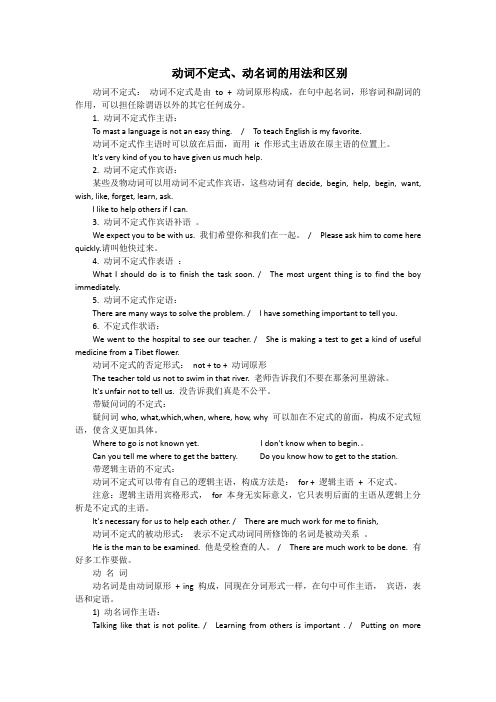
动词不定式、动名词的用法和区别动词不定式:动词不定式是由to + 动词原形构成,在句中起名词,形容词和副词的作用,可以担任除谓语以外的其它任何成分。
1. 动词不定式作主语:To mast a language is not an easy thing. / To teach English is my favorite.动词不定式作主语时可以放在后面,而用it 作形式主语放在原主语的位置上。
It's very kind of you to have given us much help.2. 动词不定式作宾语:某些及物动词可以用动词不定式作宾语,这些动词有decide, begin, help, begin, want, wish, like, forget, learn, ask.I like to help others if I can.3. 动词不定式作宾语补语。
We expect you to be with us. 我们希望你和我们在一起。
/ Please ask him to come here quickly.请叫他快过来。
4. 动词不定式作表语:What I should do is to finish the task soon. / The most urgent thing is to find the boy immediately.5. 动词不定式作定语:There are many ways to solve the problem. / I have something important to tell you.6. 不定式作状语:We went to the hospital to see our teacher. / She is making a test to get a kind of useful medicine from a Tibet flower.动词不定式的否定形式:not + to + 动词原形The teacher told us not to swim in that river. 老师告诉我们不要在那条河里游泳。
动词不定式与动名词区别与联系

动词不定式与动名词的用法及区别学案编制人:布凡(动词不定式)关敏(动名词)复查人:武长缨(一)不定式1.不定式的基本形式与结构动词不定式指通常由to加上动词原形(如to write)所构成的一种非限定性动词形式,但在有些情况下to可以省略。
动词不定式有进行体和完成体(如to be writing, to have written)也有被动态(如to be write),所有的动词,不论是及物动词还是不及物动词,也不论是动作动词还是状态动词,都有不定式形态。
助动词除be和have外,没有不定式形式。
动词不定式在语法功能上可作主语、宾语、表语、定语和状语。
2.不定式的用法一、作主语动词不定式作主语可位于句首。
例如:To learn a skill is very important for everyone in society.也可使用it作形式主语,而将其置于句末。
例如:It is necessary for young students to learn a foreign language.动词不定式作主语的常用句型有:1. It is+adj./ n. (+for sb./sth.) +to do sth.用于此句型的形容词有:easy, hard, difficult, possible, important, impossible, necessary, good, bad, exciting, interesting, surprising等。
例如:It is interesting to play this game.It is necessary for you to change your job.It was impossible for them to complete the task in such a short time.考例1:Is ____ possible to fly to the moon in a spaceship? (88 MET)A. nowB. manC. thatD. it用于此句型的名词有:pity, shame, pleasure, one’s duty, one’s job, fun, joy, good manners, bad manners 等。
动词不定式与动名词用法总结

动词不定式与动名词用法总结一动词不定式作主语(1) (1)To learn a foreign language is not easy.主语It(形式主语)is not easy to learn a foreign language(真正主语)It takes / took me 3 hours to read EnglishIt is not difficult for us to learn a foreign languageIt’s kind of you to help me with my English .1 It+is+形容词(表示人的性格品质)+of sb+to do2 It+is+形容词(表示做某事是怎么样)+for sb+to do注(1)当形容词表示人的性格品质时,逻辑主语由of引出,如:kind,nice, good, polite, clever, careful,careless,foolish,(2)当形容词表示做某事是怎么样时逻辑主语由for引出.如:difficult, hard , easy, important, dangerous possible二动词不定式宾语此种情况可按固定搭配或句式去记。
want to do agree to do hope to do decide to doprefer to do plan to do offer to do would like to doKevin planned to visit his uncle三动词不定式做宾语补足语tell sb + to do ask sb + to do want sb + to doorder sb + to do invite sb + to do warn sb + to doI tell him not to go there by bus .四:定语动词不定式做定语放在所修饰的名词、代词的后面。
高中英语知识点归纳动词的不定式与动名词

高中英语知识点归纳动词的不定式与动名词动词的不定式与动名词是英语中重要的语法知识点,具有广泛的用途。
在高中英语学习中,学生需要熟练掌握不定式和动名词的形式、用法以及常见的搭配。
本文将对动词的不定式与动名词的相关知识进行归纳总结,并给出一些常见的例句和实际运用场景。
一、动词的不定式不定式是动词的一种非谓语形式,通常由“to + 动词原形”构成。
不定式在句子中可以作为主语、宾语、表语、定语或状语。
1. 不定式作主语不定式作主语时,常常位于句首,用来指代具体的行为、想法或概念。
例句:- To learn a foreign language is not easy.(学习一门外语并不容易。
)- To avoid traffic jam, we decided to take the subway.(为了避免交通堵塞,我们决定乘地铁。
)2. 不定式作宾语不定式作宾语时,常常跟在某些动词(如want, hope, plan, decide等)后面,表示将要发生的动作。
例句:- She wants to be a doctor in the future.(她将来想成为一名医生。
)- We have decided to visit the Great Wall next week.(我们决定下周去参观长城。
)3. 不定式作表语不定式作表语时,常常跟在be动词(如is, am, are, was, were等)后面,表示主语的身份、职业或角色。
例句:- His dream is to become a famous writer.(他的梦想是成为一名著名的作家。
)- Their job is to teach English to international students.(他们的工作是教国际学生英语。
)4. 不定式作定语不定式作定语时,通常放在被修饰的名词或代词之后,用来修饰它们。
例句:- I have a book to read this weekend.(这个周末我有一本书要读。
高中英语不定式语法

非谓语动词在高中英语中,非谓语动词包括动词不定式(to do)、动名词(-ing)、现在分词(-ing)与过去分词(-ed)三种形式,它们有不少共同特点:①在句子中不能充当谓语,不受主语人称和数的限制;②保留部分动词特性:可以后接宾语,可用副词修饰;③否定形式,都是在其前面加上not/never等否定词;④表示的动作,如果明显发生的谓语动词表示的动作之前(或者强调先后),要求用完成时态形式;⑤都不能作地点状语,只有动词不定式可以作目的状语;⑥没有主语,其表示动作的执行者叫作“逻辑性主语”(主动语态时),有时表示动作的承受者(被动语态时)非谓语动词可充当句子的很多成分,并且有时态和语态的变化如下:Ⅰ动词不定式定义:动词不定式是非谓语动词的一种,它没有人称和单复数的变化,在句子中不能独立作谓语,但它仍保持动词的特点,可以有自己的宾语和状语。
一、不定式的时态和语态:1. 动词不定式的时态1). 一般式:当不定式表示的动作或状态发生几乎同时或晚于谓语动词表示的动作或状态时用一般式;eg. ①He seemed to be tired.②The building to be finished next month is for our teachers.2). 进行式:当不定式表示的动作或状态与谓语正好同时发生时,用进行式。
eg. ①When I went to his home, he happened to be traveling around the world.②I didn`t expect you to be working in such bad conditions.3). 完成式:当不定式所表示的动作或状态明显发生在谓语动词之前,用完成式;eg. ①He is said to have written a novel about the Long March.②He is said to have been taught French when he was a child.4). 完成进行式:如果不定式表示的动作发生在谓语动词之前,强调一直在进行或有可能继续进行,用完成进行式.eg. ①We are happy to have been working with the experts all the month.②I suspected him to have been playing instead of studying.5. 不定式的语态:1)当不定式的逻辑主语是其表示的动作的执行者时,一般要用主动式;eg. ①The workers are to build the great bridge.当不定式的逻辑主语正好是其表示的动作的承受者时,一般要用被动式(to be done).eg. ①The great bridge is to be built by the workers.2) 若是明显发生在谓语动作之前,而且含有被动含义,就用完成被动式( to have been done).eg. ①He is said to have written a novel about the Long March.②He is said to have been taught French when he was a child.二、不定式的功能:1. 不定式做主语:不定式做主语一般表示具体的某一次动作,而动名词doing 表示习惯的,经常的动作。
动词不定式与动名词的区别及使用方法

动词不定式与动名词的区别及使用方法动词不定式是一个动词的基本形式,通常由动词原形加上"to"构成,如"to go"。
动名词是动词的现在分词形式,通常由动词原形加上"ing"构成,如"going"。
区别:1. 功能不同:- 动词不定式可以用作句子的主语、宾语、以及补语等,并且可以表示动作的目的、意愿、能力和可能性等。
- 动名词可以用作句子的主语、宾语、介词宾语、以及形容词或副词的补语等,并且可以表示正在进行的动作或抽象的概念。
2. 结构不同:- 动词不定式可以带有自己的主语,而动名词通常没有自己的主语。
- 动词不定式可以与情态动词和助动词一起使用,而动名词通常不能与这些词一起使用。
使用方法:1. 动词不定式的使用:- 作主语:To travel is my dream.- 作宾语:I want to go on a vacation.- 表示目的:I study hard to pass the exam.- 表示意愿:I would like to visit my grandparents.- 表示能力和可能性:He is able to solve the problem.2. 动名词的使用:- 作主语:Swimming is a great exercise.- 作宾语:I enjoy reading books.- 作介词宾语:She is fond of playing the guitar.- 作补语:I am interested in learning new things.总结:动词不定式和动名词虽然在形式上有所区别,但在使用上都有自己独特的功能。
根据句子的需要和语境,我们可以选择合适的形式来表达我们想要表达的意思。
动词不定式和动名词的区别与应用
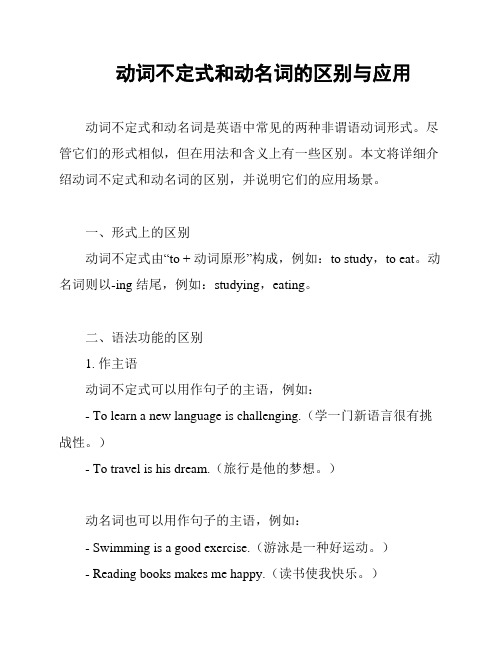
动词不定式和动名词的区别与应用动词不定式和动名词是英语中常见的两种非谓语动词形式。
尽管它们的形式相似,但在用法和含义上有一些区别。
本文将详细介绍动词不定式和动名词的区别,并说明它们的应用场景。
一、形式上的区别动词不定式由“to + 动词原形”构成,例如:to study,to eat。
动名词则以-ing 结尾,例如:studying,eating。
二、语法功能的区别1. 作主语动词不定式可以用作句子的主语,例如:- To learn a new language is challenging.(学一门新语言很有挑战性。
)- To travel is his dream.(旅行是他的梦想。
)动名词也可以用作句子的主语,例如:- Swimming is a good exercise.(游泳是一种好运动。
)- Reading books makes me happy.(读书使我快乐。
)2. 作宾语动词不定式可以用作及物动词的宾语,例如:- I want to learn Spanish.(我想学西班牙语。
)- She likes to eat fruits.(她喜欢吃水果。
)动名词也可以用作及物动词的宾语,例如:- I enjoy swimming every morning.(我喜欢每天早上游泳。
)- He admitted stealing the money.(他承认偷了那笔钱。
)3. 作介词宾语动词不定式可以用作介词宾语,例如:- She is good at playing the guitar.(她弹吉他很好。
)- He is interested in learning Chinese.(他对研究中文感兴趣。
)动名词也可以用作介词宾语,例如:- They are looking forward to visiting Paris.(他们期待着去巴黎旅行。
)三、意义和用法的区别1. 动词不定式带有“to”的含义,表示目的、意图、可能性、建议等,例如:- I went to the store to buy some bread.(我去商店买面包。
动词的不定式与动名词的区别

动词的不定式与动名词的区别动词的不定式(infinitive)和动名词(gerund)是英语中两种常见的非谓语动词形式。
尽管在形式上它们有一些相似之处,但在用法和含义上有明显的区别。
本文将详细介绍动词的不定式和动名词的区别,以便读者更好地理解和运用它们。
一、形式上的区别1. 动词的不定式通常由“to + 动词原形”构成,例如:to learn,to eat,to go等。
2. 动名词则是在动词原形后面直接加上-ing,例如:learning,eating,going等。
二、用法上的区别1. 主语的区别:a) 不定式作为主语:不定式一般用作主语时,表示一种抽象的行为、概念或目的。
例如:- To learn a new language is challenging.(学一门新语言很有挑战性。
)b) 动名词作为主语:动名词用作主语时,表示一种具体的、实际的行为或活动。
例如:- Reading helps expand your vocabulary.(阅读有助于扩大你的词汇量。
)2. 宾语的区别:a) 不定式作为宾语:不定式可以作为及物动词或不及物动词的宾语,常用于某些动词后,例如:want,hope,decide等。
例如: - She wants to learn Chinese.(她想学中文。
)b) 动名词作为宾语:动名词一般用作及物动词的宾语,常用于某些动词后,例如:enjoy,like,dislike等。
例如:- He enjoys swimming in the ocean.(他喜欢在海里游泳。
)3. 表语的区别:a) 不定式作为表语:不定式可以用作表语,通常用于表示完成、未来或可能性等。
例如:- His dream is to become a doctor.(他的梦想是成为一名医生。
)b) 动名词作为表语:动名词不常用作表语。
4. 定语的区别:a) 不定式作为定语:不定式可以用作修饰名词或代词的定语,常用于表示目的、原因或解释等。
(完整版)高中英语语法动词不定式和动名词做宾语
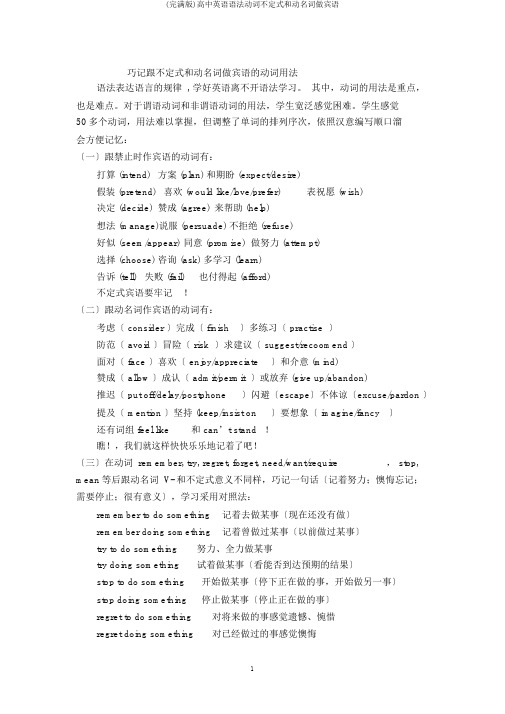
巧记跟不定式和动名词做宾语的动词用法语法表达语言的规律 , 学好英语离不开语法学习。
其中,动词的用法是重点,也是难点。
对于谓语动词和非谓语动词的用法,学生宽泛感觉困难。
学生感觉50多个动词,用法难以掌握,但调整了单词的排列序次,依照汉意编写顺口溜会方便记忆:〔一〕跟禁止时作宾语的动词有:打算 (intend)方案 (plan) 和期盼 (expect/desire)假装 (pretend)喜欢 (would like/love/prefer)表祝愿 (wish)决定 (decide)赞成 (agree)来帮助 (help)想法 (manage)说服 (persuade) 不拒绝 (refuse)好似 (seem/appear)同意 (promise) 做努力 (attempt)选择 (choose) 咨询 (ask) 多学习 (learn)告诉 (tell) 失败 (fail)也付得起 (afford)不定式宾语要牢记!〔二〕跟动名词作宾语的动词有:考虑〔 consider 〕完成〔 finish〕多练习〔 practise 〕防范〔 avoid 〕冒险〔 risk〕求建议〔 suggest/recoomend 〕面对〔 face 〕喜欢〔 enjoy/appreciate〕和介意 (mind)赞成〔 allow 〕成认〔 admit/permit 〕或放弃 (give up/abandon)推迟〔 put off/delay/postphone〕闪避〔escape〕不体谅〔excuse/pardon 〕提及〔 mention 〕坚持 (keep/insist on〕要想象〔 imagine/fancy〕还有词组 feel like和 can’t stand!瞧!,我们就这样快快乐乐地记着了吧!〔三〕在动词 remember, try, regret, forget, need/want/require, stop, mean等后跟动名词 V- 和不定式意义不同样,巧记一句话〔记着努力;懊悔忘记;需要停止;很有意义〕,学习采用对照法:remember to do something记着去做某事〔现在还没有做〕remember doing something记着曾做过某事〔以前做过某事〕try to do something努力、全力做某事try doing something试着做某事〔看能否到达预期的结果〕stop to do something开始做某事〔停下正在做的事,开始做另一事〕stop doing something停止做某事〔停止正在做的事〕regret to do something对将来做的事感觉遗憾、惋惜regret doing something对已经做过的事感觉懊悔mean to do something打算,想,意⋯mean doing something意味着want/require/need to be done某事需要做want/require/need doing 某事需要做 ( 名和主之有关系,如: The room needs cleaning/needs to be cleaned)can’t help to do sth.不能够帮助做某事can’t help doing sth.不由得做某事〔四〕牢在以下固定句式中,用V-ing 式:There is no point arguing further.再争下去没有意。
高中英语句型归纳+动词不定式、动名词用法要点讲解
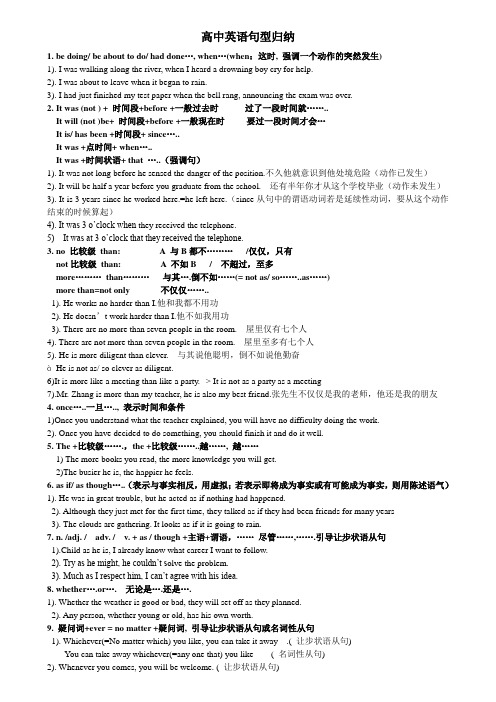
高中英语句型归纳1. be doing/ be about to do/ had done…, when…(when:这时, 强调一个动作的突然发生)1). I was walking along the river, when I heard a drowning boy cry for help.2). I was about to leave when it began to rain.3). I had just finished my test paper when the bell rang, announcing the exam was over.2. It was (not ) + 时间段+before +一般过去时过了一段时间就……..It will (not )be+ 时间段+before +一般现在时要过一段时间才会…It is/ has been +时间段+ since…..It was +点时间+ when…..It was +时间状语+ that …..(强调句)1). It was not long before he sensed the danger of the position.不久他就意识到他处境危险(动作已发生)2). It will be half a year before you graduate from the school. 还有半年你才从这个学校毕业(动作未发生)3). It is 3 years since he worked here.=he left here.(since从句中的谓语动词若是延续性动词,要从这个动作结束的时候算起)4). It was 3 o’clock when they received the telephone.5) It was at 3 o’clock that they received the telephone.3. no 比较级than: A 与B都不………/仅仅,只有not比较级than: A 不如B / 不超过,至多more………than………与其….倒不如……(= not as/ so……..as……)more than=not only 不仅仅……..1). He works no harder than I.他和我都不用功2). He doesn’t work harder than I.他不如我用功3). There are no more than seven people in the room. 屋里仅有七个人4). There are not more than seven people in the room. 屋里至多有七个人5). He is more diligent than clever. 与其说他聪明,倒不如说他勤奋àHe is not as/ so clever as diligent.6)It is more like a meeting than like a party.--> It is not as a party as a meeting7).Mr. Zhang is more than my teacher, he is also my best friend.张先生不仅仅是我的老师,他还是我的朋友4. once…..一旦….., 表示时间和条件1)Once you understand what the teacher explained, you will have no difficulty doing the work.2). Once you have decided to do something, you should finish it and do it well.5. The +比较级…….,the +比较级……..越……, 越……1) The more books you read, the more knowledge you will get.2)The busier he is, the happier he feels.6. as if/ as though…..(表示与事实相反,用虚拟;若表示即将成为事实或有可能成为事实,则用陈述语气)1). He was in great trouble, but he acted as if nothing had happened.2). Although they just met for the first time, they talked as if they had been friends for many years3). The clouds are gathering. It looks as if it is going to rain.7. n. /adj. / adv. / v. + as / though +主语+谓语,……尽管……,…….引导让步状语从句1).Child as he is, I already know what career I want to follow.2). Try as he might, he couldn’t s olve the problem.3). Much as I respect him, I can’t agree with his idea.8. whether….or…. 无论是….还是….1). Whether the weather is good or bad, they will set off as they planned.2). Any person, whether young or old, has his own worth.9. 疑问词+ever = no matter +疑问词, 引导让步状语从句或名词性从句1). Whichever(=No matter which) you like, you can take it away .( 让步状语从句)You can take away whichever(=any one that) you like ( 名词性从句)2). Whenever you comes, you will be welcome. ( 让步状语从句)3). Whatever happens, I will support you. ( 让步状语从句)4). Whoever breaks the law, he will certainly be punished. ( 让步状语从句)àWhoever breaks the law will certainly be punished. ( 名词性从句)5). However great the difficulty is, we can overcome it. ( 让步状语从句)10. if/ as long as/so long as/ providing that/ provided that/ supposing that/ on condition that 假如….. 1). I will lend you money on condition that you can return it within 3 months.11. given that/ considering that 考虑到….., 鉴于……1). Given her interest in children/ Given that she is interest ed in children, I’m sure teaching is the right career for her.2). Considering his age and his experience, he has done well.12. in case that/ in case of….. 万一….., 以防…..1). In case of fire, please dial 119 at once.2). In case that John comes/ John should come, tell him to wait.13. 祈使句+ or/otherwise +结果句或祈使句+ and +结果句1). Stop doing such foolish thing, or you will be punished in time.2). More effort, and the problem would have been settled.3). Think it over, and you will find the answer.14. so/ such……..that…….引导结果状语从句时须注意当名词前many, much, little, few有修饰时, 用so不用such因为此时的中心词不再是名词,而是many, much, little, few这些表示数量的词。
动名词和不定式的区别
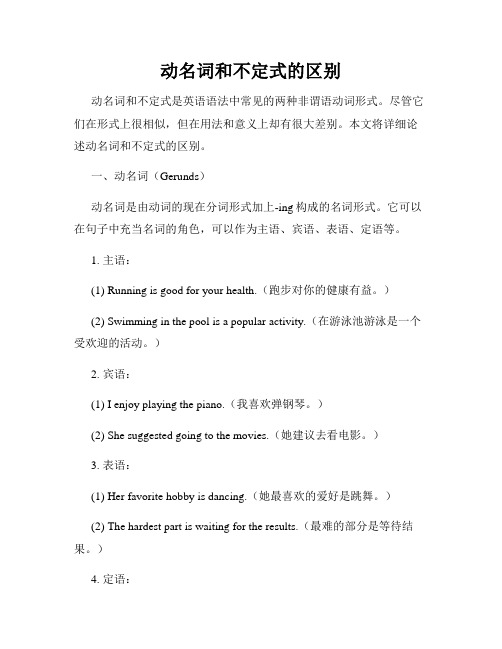
动名词和不定式的区别动名词和不定式是英语语法中常见的两种非谓语动词形式。
尽管它们在形式上很相似,但在用法和意义上却有很大差别。
本文将详细论述动名词和不定式的区别。
一、动名词(Gerunds)动名词是由动词的现在分词形式加上-ing构成的名词形式。
它可以在句子中充当名词的角色,可以作为主语、宾语、表语、定语等。
1. 主语:(1) Running is good for your health.(跑步对你的健康有益。
)(2) Swimming in the pool is a popular activity.(在游泳池游泳是一个受欢迎的活动。
)2. 宾语:(1) I enjoy playing the piano.(我喜欢弹钢琴。
)(2) She suggested going to the movies.(她建议去看电影。
)3. 表语:(1) Her favorite hobby is dancing.(她最喜欢的爱好是跳舞。
)(2) The hardest part is waiting for the results.(最难的部分是等待结果。
)4. 定语:(1) I have a painting class every Tuesday.(我每周二有一节绘画课。
)(2) The running shoes are on sale.(跑鞋正在打折。
)二、不定式(Infinitives)不定式是由to加上动词原形构成的形式。
不定式可以在句子中充当动词、形容词或名词的角色,可以作为动词、定语、表语等。
1. 动词:(1) She wants to learn a new language.(她想学一门新语言。
)(2) They decided to go on a trip together.(他们决定一起去旅行。
)2. 定语:(1) I need a pen to write the report.(我需要一支笔来写报告。
高中英语 动词不定式和动名词
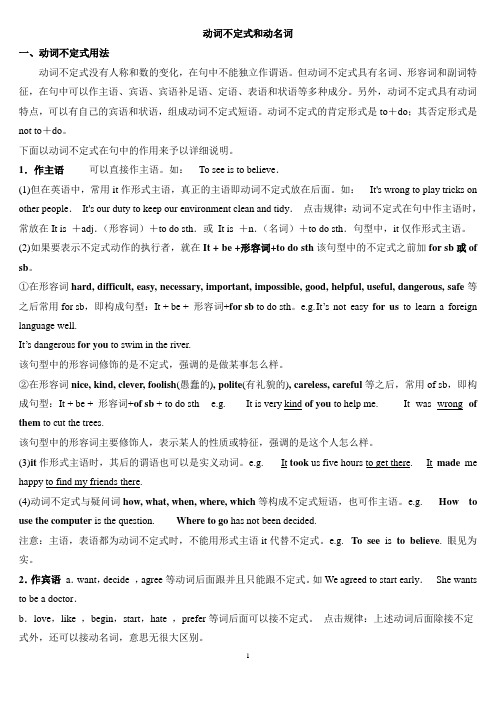
动词不定式和动名词一、动词不定式用法动词不定式没有人称和数的变化,在句中不能独立作谓语。
但动词不定式具有名词、形容词和副词特征,在句中可以作主语、宾语、宾语补足语、定语、表语和状语等多种成分。
另外,动词不定式具有动词特点,可以有自己的宾语和状语,组成动词不定式短语。
动词不定式的肯定形式是to+do;其否定形式是not to+do。
下面以动词不定式在句中的作用来予以详细说明。
1.作主语可以直接作主语。
如:To see is to believe.(1)但在英语中,常用it作形式主语,真正的主语即动词不定式放在后面。
如:It's wrong to play tricks on other people.It's our duty to keep our environment clean and tidy.点击规律:动词不定式在句中作主语时,常放在It is +adj.(形容词)+to do sth.或It is +n.(名词)+to do sth.句型中,it仅作形式主语。
(2)如果要表示不定式动作的执行者,就在It + be +形容词+to do sth该句型中的不定式之前加for sb或of sb。
①在形容词hard, difficult, easy, necessary, important, impossible, good, helpful, useful, dangerous, safe等之后常用for sb,即构成句型:It + be + 形容词+for sb to do sth。
e.g. I t’s not easy for us to learn a foreign language well.It’s dangerous for you to swim in the river.该句型中的形容词修饰的是不定式,强调的是做某事怎么样。
②在形容词nice, kind, clever, foolish(愚蠢的), polite(有礼貌的), careless, careful等之后,常用of sb,即构成句型:It + be + 形容词+of sb + to do sth e.g. It is very kind of you to help me. It was wrong of them to cut the trees.该句型中的形容词主要修饰人,表示某人的性质或特征,强调的是这个人怎么样。
英语非谓语动词:不定式,动名词和分词

英语非谓语动词:不定式,动名词和分词非谓语动词分为三种形式:不定式、动名词和分词(包括现在分词和过去分词)(一)动词不定式动词不定式可以作主语、宾语、宾语补足语、定语、状语、表语。
动词不定式由“to+动词原形”构成,否定形式“not to +动词原形”。
1.用法(1)作主语。
往往用it作为形式主语。
如:It is time to get up.(2)作宾语。
如果带有宾语补足语,往往把不定式短语放在宾语补足语之后,用it作形式宾语。
如:I find it interesting to study English.有些动词只能用动词不定式作宾语。
如:decide,plan,desire,hope,wish,promise,ask,agree, manage等。
(3)作宾语补足语A:带to的动词不定式有:ask,tell,want,teach,advise,allow,beg,invite等。
如:He asked me to do the work.B :接不带to的动词不定式有:see,watch,hear,make ,let等。
如:I often see him play football.使役动词不带to,动词有:一感二听三让四观看。
一感:feel 二听:hear, listen to 三让:let,have,make 四观看:observe,see,watch,look at注意:feel, hear,notice, see,watch,have,make等词后的补足语中,不定式不带to,但变成被动结构时,要带to.如:I often hear him cry. He is often heard to cry.注意:带but介词的不定式。
如果介词之前有行为动词do的各种形式,那么but后的不定式不带to,否则要带to。
另外,在can’t choose but...和can’t help but...等后面的不定式也省略to。
动词不定式和动名词的用法和区别详解

动词不定式和动名词的用法和区别详解动词不定式是由动词原形加上to构成的形式,通常作为动词、形容词或副词的宾语、补语、定语或状语。
动词不定式可以表示目的、结果、愿望、能力、需要、义务等含义。
动名词是由动词加上-ing构成的形式,可以作为名词的主语、宾语、定语或表语。
动名词通常表示行为或状态的持续性或重复性。
两者的区别如下:1. 形式上的区别:- 动词不定式以to开头,如to eat、to sleep。
- 动名词以-ing结尾,如eating、sleeping。
2. 用法上的区别:- 动词不定式通常用作动词的宾语,如I want to eat。
它可以跟在某些动词后面,如want、like、hope等,构成不定式短语。
- 动名词通常可以用作名词的主语、宾语或表语,如Smokingis bad for health。
3. 意义上的区别:- 动词不定式强调的是动作的目的、结果、愿望、能力等。
例如,I want to learn English。
在这个句子中,不定式to learn强调的是想要研究英语的目的。
- 动名词强调的是动作的持续性或重复性。
例如,I enjoy swimming。
在这个句子中,动名词swimming强调的是游泳这个持续性的动作带来的愉悦感。
需要注意的是,有些动词后既可以接动词不定式,也可以接动名词,但意义可能会有所不同。
例如,I like swimming和I like to swim的意思虽然都是“我喜欢游泳”,但前者强调的是游泳这个动作本身,而后者强调的是我想要做游泳这个动作。
总结起来,动词不定式和动名词在形式、用法和意义上存在一些区别。
了解这些区别有助于我们正确使用它们,并更好地理解英语句子的含义和表达方式。
参考资料:- 李强,牛津英语语法详解,外语教学与研究出版社,2001年。
高中英语知识点归纳动词的不定式与动名词的特殊用法

高中英语知识点归纳动词的不定式与动名词的特殊用法动词的不定式与动名词是英语语法中的重要部分,它们有着特殊的用法。
掌握了这些用法,可以帮助我们更准确地表达意思。
本文将对高中英语中动词的不定式与动名词的特殊用法进行归纳总结。
一、不定式的特殊用法1. 作主语不定式可以作为句子的主语,常见的形式有:"To do good is important." (做好事很重要)"It is important to do good." (做好事很重要)在这种用法中,不定式起到名词的作用,整个不定式短语作为句子的主语。
2. 作宾语不定式可以作为及物动词的宾语。
常见的动词有:want, plan, hope, decide, promise, agree等。
例如:"I want to go shopping."(我想去购物)"She promised to help me."(她答应帮助我)3. 作目的状语不定式可以表示动作的目的,常与动词prepare, learn, go等连用。
例如:"I am studying hard to pass the exam."(我正在努力学习以通过考试)"She bought some flowers to decorate the room."(她买了些花来装饰房间)4. 作结果状语不定式可以表示动作的结果,常与形容词或副词连用。
例如:"He is too young to drive."(他太年轻不能开车)"She is too tired to work."(她太累不能工作)二、动名词的特殊用法1. 作主语动名词可以作为句子的主语,常见的形式有:"Swimming is my favorite sport."(游泳是我最喜欢的运动)"Reading helps improve vocabulary."(阅读有助于提高词汇量)2. 作宾语动名词可以作为及物动词的宾语。
高一英语非谓语动词—动词不定式及动名词知识精讲

高一英语非谓语动词—动词不定式与动名词【本讲主要内容】非谓语动词——动词不定式与动名词【知识总结归纳】非谓语动词包括动词不定式,动名词和分词.〔1〕非谓语动词不可以单独作谓语,在形式上不受人称和数的限制.〔2〕非谓语动词如果是与物动词, 应该带宾语.〔3〕非谓语动词可以有状语来修饰.〔4〕非谓语动词仍有时态和语态的变化.I.动词不定式: to + 动词原形动词不定式具有名词,形容词和副词的特征,在句子中可以作主语,表语,宾语,定语和状语。
1. 作主语:To talk with him is a great pleasure.动词不定式作主语时, 往往放在谓语动词的后面,用作形式主语.It is a great pleasure to talk with him.有很多形容词都可以放在这个句型中:difficult, easy, hard, impossible, dangerous, safe, expensive, cheap impossibleDo you think it is safe to drink this water?Your writing is awful. It is impossible to read it.I like being with Jill. It’s very interesting to talk to her.It is not difficult to learn a foreign language if you spend time and effort on it.在形容词kind, clever, silly, stupid, careless, unfair , considerate 等前应该用介词of.It’s silly of Mary to give up her job when she needs the money.I think it was very helpful of them to tell me the truth.2. 作表语:Her wish is to become a teacher when she grows up.Our plan is to finish the plan in two weeks.3. 作宾语:Do you like to watch football matches?We decided to make changes in our plan.常见的后面跟不定式作宾语的动词有:offer, decide, agree, plan, hope, learn, forget, fail, attempt, promise, arrange, afford, manage等.How old were you when you learn to drive?We decided not to go out because of the bad weather.I promised not to be late.有些形容词后面也可以接动词不定式ready, eager, anxious, able, sure, glad, sorry, afraid, free, pleased, willingThe boys and girls are eager to learn to swim.I’m sorry to trouble you.He is willing to help the people in need.有些动词后可以用疑问词+ 不定式的结构ask, decide, know, remember, forget , explain ,learn, wonderWe asked how to get to the airport?Have you decided where to go for your holidays?Do you understand what to do?4. 作宾补:可以带宾补的动词有:ask, order, persuade, advise, like, want, tell, know, helpwarn, invite, persuade, get, expect, would like, would loveThe doctor advised him to have a good rest.I didn’t move the piano by myself. I got somebody to help me.I was warned not to touch the switch.My father allowed me to use his car.在某些与物动词的复合宾语中, 动词不定式要省掉to, 常见的省to的动词有:make, let, have, see, watch, hear, feel , help等I heard him speak in the next room.Liz suddenly felt something touch her on the shoulder.I saw him fall off the wall.Did anybody see the accident happen?The ending of the story made me feel sad.5. 作定语:动词不定式作定语时须放在被修饰的名词或代词之后.He is always the first one to get up.I have a few words to say on this question.Attention, please! I have something important to say.6. 作状语:不定式作状语通常表示目的或结果---- Why did you go out?---- To post a letter.A friend of mine phoned to invite me to a party.A few years later he came home to find that his hometown had greatly changed.I went to see him only to find him out.II. 动名词由动词原形+ 词尾ing 构成.动名词有名词的特征, 在句中可以作主语, 宾语,表语等.1. 作主语:Getting up early is a good habit.Seeing is believing.Reading aloud is very important in learning English.It’s no use trying to persuade me.There’s nothing you can do about the situation, so it’s no good worrying ab out it.2. 作表语:Her job is looking after the babies.His hobby is collecting stamps.3. 作宾语:常跟动名词作宾语的动词:stop, delay, consider, admit, miss, finish, postpone, imagine, avoid, risk practiseSuddenly everybody stopped talking. There was silentce.I’ll do the shopping when I’ve finished cleaning the flat.He tried to avoid answering my question.Have you ever considered going to live in another country.一些短语后面也用动名词做宾语:give up, put off, carry on, go on, keep onHe has given up smokingWe must do something. We can’t go on living like that.Don’t keep interrupting me while I’m speaking.介词后接动名词作宾语:before, after, be interested in, be good at, how about, instead of, in spite of, without, be used to, look forward to, have difficulty in, succe ed in, insist on, think of, feel like, stop… from, Are you interested in working for us?I’m not very good at learning languages.Carol went to work in spite of feeling ill.I bought a new bicycle instead of going away on holiday.What did you do after leaving school?I ran ten kilometers without stopping.Do you feel like going out tonight?The police stopped everyone from leaving the building.【高考点拨】【题型展示】〔〕 1. The patient was warned _____ oily food after the operation.A. to eat notB. eating notC. not to eatD. not eating此题应选C, warn sb. not to do sth. 意思是警告某人不要做某事.〔〕 2. The purpose of new technologies is to make life easier , __________ it more difficult .A. not makeB. not to makeC. not makingD. do not make此题应选B, 动词不定式在这里是作表语的.〔〕 3. Robert is said ______ abroad, but I don’t know what country he studied in.A. to have studiedB. to studyC. to be studyingD. to have been studying此题应选A, sb. be said to be, 意思是据说, 在这里用不定式的完成时, 指的是发生在过去的事.〔〕 4. I’ve worked with children before , so I know what ______ in my new job.A. expectedB. to expectC. to be expectingD. expects此题应选B, know 后面接动词不定式,不定式前面可以带一个疑问词.〔〕 5. The managers discussed the plan that they would like to see ______ the next year.A. carry outB. carrying outC. carried outD. to carry out此题应选C, plan 为定语从句的先行词, 后面为它的定语从句. 在从句中, 短语see sth. done 意思是“看见…被….〞〔〕 6. I usually go there by train.--- Why ______ going there by boat for a change?A.don’t tryB. not tryC. not to tryD. not trying此题应选B, why not do sth. 为一个词组, 表示一种建议语气.〔〕7. We don’t know who stole the book. What’s you r opinion?--- Jack is considered _______ it.A. having doneB. doingC. to have doneD. to do此题应选B, consider 后面应该用动名词作宾语.〔〕8. The place is really beautiful . We all think it worth ______ .A. being visitedB. to be visitedC. a visitD. to visit此题应选C, worth 后面可以跟动名词作它的宾语,A、B、D答案都不是,因此我们选择名词作宾语.〔〕9. He advised _____ at the school gate the next day.A. our meetingB. to meetC. us meetingD. met此题应选A, advise 后接动名词作宾语, 动名词前面可以有一个逻辑主语,用形容词性的物主代词.〔〕10. The computer is _______ to be one of the greatest inventions of the 20th century.A. regardedB. consideredC. expectedD. suggested此题应选B, consider 在这里是认为的意思. c onsider sb. to be ….【实战模拟】〔〕 1. The experienced driver has got ______ in all kinds of weather.A. used to driveB. used to drivingC. use to driveD. use to driving〔〕2. I’m too tired. I prefer _____ rather than go to the cinema.A. to stay homeB. to staying homeC. stay homeD. staying home〔〕 3. Her father considered _____ to a foreign friend.A. writingB. writeC. to writeD. wrote〔〕 4. You’d better _____ tell a lie. I think it ______ tell the teacher all that had happened yesterday.A. not. would betterB. not, is better toC. not to, would better toD. not to, better〔〕 5. The young couple came to the ball without ______ .A. being invitedB. invitingC. been invitedD. invite〔〕 6. He was surprised to find the back window of his house ______ . He was evenmore surprised to find his computer ______ .A. broken, goneB. had broken, goingC. being broken, disappearedD. had been broken, missed〔〕7. Please speak a little louder to make yourself _____ .A. to hearB. hearC. heardD. hearing〔〕8. The dish isn’t warm enough now. You’d better get it _____ .A. to heatB. to be heatedC. heatedD. heating〔〕9. --- What’s in your bag?--- Books _________to the teacher tomorrow.A. sentB. to be sentC. being sentD. sending〔〕10. I can hardly imagine Peter _____ across the Atlantic Ocean in five hours.A. sailB. to sailC. sailingD. to have sailed试题答案1. B2. A3. A4. B5. A6. A.7. C8.C9. B 10. C。
(完整版)动名词、动词不定式、分词作定语区别

动词的不定式,\分词\.动名词的区别及其用法、搭配。
答:非谓语动词包括动词不定式.动名词和分词三种形式,分词又包括现在分词和过去分词.这三种形式都是由动词变来的,但在句子中都不能作谓语,故这三种形式被称为非谓语动词。
下面就这三种形式在用法上的区别浅析如下:一、动词不定式和动名词在句子中均可作主语和表语在表示一个具体的。
个别的或将来的动作时,要用动词不定式.如:My job is to teach the first-year students grammar.To study English well is very important。
在表示比较抽象的一般的行为和动作时,二者可以互换。
如:To climb mountains is a good form of exercise。
Climbing mountains is a good form of exercise。
二、动名词、现在分词和动词不定式都可以作定语1.动名词作定语时,和它所修饰的名词之间没有逻辑上的主谓关系,只表示被修饰名词的一般用途,必须位于名词之前。
如:There is a swimming pool in our school.2。
现在分词作定语时,和它所修饰的名词之间有逻辑上的主谓关系,表示所修饰名词的特征.如:Listen to the singing bird。
Who is the boy running towards us。
3。
动词不定式作定语时,当所修饰的名词指人时,和它所修饰的名词之间有逻辑上的主谓关系。
如:He is always the first to come to school.当所修饰的名词指物时,和它所修饰的名词之间有逻辑上的动宾关系.如:I have a meeting to attend。
如果作定语的动词不定式中的动词是不及物动词,需加上相应的介词。
如:I have no room to live in。
动词不定式与动名词的区别及用法

动词不定式与动名词的区别及用法动词不定式和动名词是英语中两种常见的动词形式。
虽然它们在形式和用法上有些不同,但它们都可以在句子中充当动词。
动词不定式形式动词不定式由"to"加上动词的原形构成,例如:"to eat"、"to run"。
用法动词不定式可以用作下列几种情况中的动词:1. 作为动词的主语:- "To swim is my favorite activity."(游泳是我最喜欢的活动。
)2. 作为动词的宾语:- "I want to learn French."(我想要学法语。
)3. 作为动词的补充:- "She asked me to help her with the project."(她要我帮她完成这个项目。
)4. 作为不定式短语:- "He went to see a movie."(他去看电影了。
)5. 作为形容词的修饰:- "She has a book to read."(她有一本要读的书。
)动名词形式动名词是动词以-ing形式构成的名词形式。
例如:"eating"、"running"。
用法动名词可以用作下列几种情况中的名词:1. 作为主语:- "Eating healthy is important for your well-being."(健康饮食对于你的健康很重要。
)2. 作为宾语:- "I enjoy running in the park."(我喜欢在公园里跑步。
)3. 作为动词的补充:- "I appreciate your helping me with the chores."(我感谢你帮助我做家务。
动词不定式与动名词的区别与用法比较动词不定式与动名词的语法结构与用法
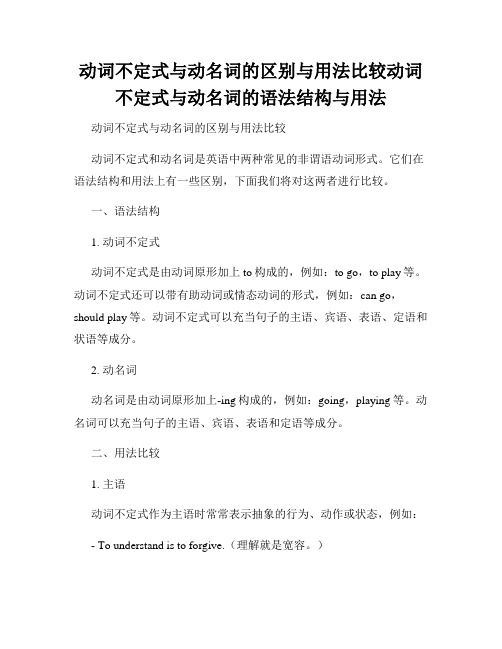
动词不定式与动名词的区别与用法比较动词不定式与动名词的语法结构与用法动词不定式与动名词的区别与用法比较动词不定式和动名词是英语中两种常见的非谓语动词形式。
它们在语法结构和用法上有一些区别,下面我们将对这两者进行比较。
一、语法结构1. 动词不定式动词不定式是由动词原形加上to构成的,例如:to go,to play等。
动词不定式还可以带有助动词或情态动词的形式,例如:can go,should play等。
动词不定式可以充当句子的主语、宾语、表语、定语和状语等成分。
2. 动名词动名词是由动词原形加上-ing构成的,例如:going,playing等。
动名词可以充当句子的主语、宾语、表语和定语等成分。
二、用法比较1. 主语动词不定式作为主语时常常表示抽象的行为、动作或状态,例如:- To understand is to forgive.(理解就是宽容。
)- To love someone is to accept them for who they are.(爱一个人就是接受他们的真实面貌。
)动名词作为主语时常常表示一般的、具体的动作或状态,例如:- Swimming is good for health.(游泳对健康有好处。
)- Eating too much junk food can lead to health problems.(吃太多垃圾食品会导致健康问题。
)2. 宾语动词不定式作为及物动词的宾语时,在一些动词后面常常跟上动词不定式,例如:- I want to go shopping.(我想去购物。
)- She loves to sing.(她喜欢唱歌。
)动名词作为宾语时,常常跟动词之后,例如:- I enjoy swimming in the sea.(我喜欢在海里游泳。
)- They avoid talking about the problem.(他们避免谈论这个问题。
)3. 表语动词不定式作为表语时,常常表示主语的性质、身份、目的等,例如:- His dream is to become a famous singer.(他的梦想是成为一名著名的歌手。
- 1、下载文档前请自行甄别文档内容的完整性,平台不提供额外的编辑、内容补充、找答案等附加服务。
- 2、"仅部分预览"的文档,不可在线预览部分如存在完整性等问题,可反馈申请退款(可完整预览的文档不适用该条件!)。
- 3、如文档侵犯您的权益,请联系客服反馈,我们会尽快为您处理(人工客服工作时间:9:00-18:30)。
动词不定式和动名词一、动词不定式用法动词不定式没有人称和数的变化,在句中不能独立作谓语。
但动词不定式具有名词、形容词和副词特征,在句中可以作主语、宾语、宾语补足语、定语、表语和状语等多种成分。
另外,动词不定式具有动词特点,可以有自己的宾语和状语,组成动词不定式短语。
动词不定式的肯定形式是to+do;其否定形式是not to+do。
下面以动词不定式在句中的作用来予以详细说明。
1.作主语可以直接作主语。
如:To see is to believe.(1)但在英语中,常用it作形式主语,真正的主语即动词不定式放在后面。
如:It's wrong to play tricks on other people.It's our duty to keep our environment clean and tidy.点击规律:动词不定式在句中作主语时,常放在It is +adj.(形容词)+to do sth.或It is +n.(名词)+to do sth.句型中,it仅作形式主语。
(2)如果要表示不定式动作的执行者,就在It + be +形容词+to do sth该句型中的不定式之前加for sb或of sb。
①在形容词hard, difficult, easy, necessary, important, impossible, good, helpful, useful, dangerous, safe等之后常用for sb,即构成句型:It + be + 形容词+for sb to do sth。
e.g. I t’s not easy for us to learn a foreign language well.It’s dangerous for you to swim in the river.该句型中的形容词修饰的是不定式,强调的是做某事怎么样。
②在形容词nice, kind, clever, foolish(愚蠢的), polite(有礼貌的), careless, careful等之后,常用of sb,即构成句型:It + be + 形容词+of sb + to do sth e.g. It is very kind of you to help me. It was wrong of them to cut the trees.该句型中的形容词主要修饰人,表示某人的性质或特征,强调的是这个人怎么样。
(3)it作形式主语时,其后的谓语也可以是实义动词。
e.g. It took us five hours to get there. It made me happy to find my friends there.(4)动词不定式与疑问词how, what, when, where, which等构成不定式短语,也可作主语。
e.g. How to use the computer is the question. Where to go has not been decided.注意:主语,表语都为动词不定式时,不能用形式主语it代替不定式。
e.g. To see is to believe. 眼见为实。
2.作宾语a.want,decide ,agree等动词后面跟并且只能跟不定式。
如We agreed to start early.She wants to be a doctor.b.love,like ,begin,start,hate ,prefer等词后面可以接不定式。
点击规律:上述动词后面除接不定式外,还可以接动名词,意思无很大区别。
提示板:like doing指经常性动作,而like to do指一次性的动作。
如:I like swimming,but I don't like to swim now.我喜欢游泳,但我现在不想游。
c.stop,forget,remember,go on ,try等词或短语后面可以接不定式。
点击规律:上述动词后面接不定式和接动名词意思大不相同。
提示板:1)stop to do sth.:停止一件事,去做另一件事。
stop doing sth.:停止正在做的事。
例句:When the teacher came in,the students stopped talking;when he came out,the students stopped to talk.当老师走进来时,学生们停止说话;当老师走出去时,学生们又开始说话。
2)思考:forget,remember,go on,try等词或短语后面接不定式和动名词用法有何区别d.在find/feel+it+adj.+to do sth.句型中,it是形式宾语,真正的宾语是后面的动词不定式。
如:The man downstairs found it difficult to get to sleep.I feel it easy to recite the text.点击规律:某些动词或短语后面既可以接动词不定式作宾语,又可接动名词作宾语,二者用法上的区别可以通过造句子加以区分,如上面stop例句。
3.作宾语补足语a.tell,ask,want,order,teach,invite,warn,wish,help,get,wish,help等词后面常接不定式作宾补。
如I tell him not to go there by bus .Edison's mother taught him to read and write.b.let,make,have,see,hear,feel,watch,notice后面接不带to的不定式作宾补。
如:The boss makes them work 16 hours a day.I heard her sing in the next room.提示板:若变成被动语态,在上述结构中,不定式符号to要加上。
如:They are made to work 16 hours a day by the boss.She was heard to sing in the next room.4.作定语:放在被修饰的名词、代词后面例句:I have a lot of work to do.The doctor said he could do nothing to help the boy.点击规律:动词不定式若在句中作定语,常放在被修饰的名词、代词之后。
提示板:如果动词不定式和前面所修饰的词构成动宾关系,若动词是不及物动词,切记不要忘掉介词。
如:I have a small bedroom to live in.Have you got some pens to write with?5.表语:放在连系动词be后面例句:His wish is to become a scientist.The first important thing is to save the soldiers' lives.点击规律:动词不定式在句中作表语时,通常对连系动词前面的名词进行诠释说明。
6.作状语a.目的状语:放在go,come,use,live,in order等词后面。
如I come to see you.He runs fast in order to get there in time.b.原因状语:放在sorry,glad,surprised,disappointed,excited等词后面。
如I am glad to see you here.I am sorry to trouble you.c.作结果状语。
如:Some of the apples are hard to reach.The room is large enough to hold 1000 people.7.与what,who,whose,when,where,how等疑问词连用,作宾语、宾语补足语、主语等。
如:I don't know what to do next.(宾语)He taught us how to use the computer.(宾语补足语)It's still a question how to get there.(主语)二、动名词的用法动名词是动词的一种非谓语形式,由动词+ ing构成,否定形式为not doing,具有动词和名词的性质,在句中起名词作用,可作主语、宾语、表语和定语。
1.作主语动名词是由动词变化而来,所以,动名词的意义往往是表示某个动作或某件事情。
例如:Walking is good exercise. Seeing is believing. Smoking may cause cancer. Coming to Hangzhou by train takes about 16 hours. Swimming develops the muscles.动名词作主语时,对于一些比较长的动名词短语,一般采用"It is …"和"There is …"两种句式来表示。
例如: It's nice talking with you. It's no use arguing with him. It is no good learning without practice. It is worthwhile consulting your tutor about it again. There is no joking about such matters. There is no harm in doing so.2、作定语动名词作定语的情况并不是很普遍,一般只限于单个的动名词作定语,表示“用于……的”或表示“处于某件事情中的……”含义。
例如: swimming pool 游泳池 reading material 阅读材料walking stick 手杖opening speech 开幕词listening aid 助听器running water 自来水developing countries 发展中国家working people 劳动人民sleeping child 熟睡孩子当分词短语做后置定语时,可以转换成定语从句。
例:She went on board the train leaving for Shanghai. = She went on board the train, which was leaving for Shanghai. There are two roads before us, one leading to the beach, the other to the park.= There are two roads before us, one which leads to the beach, the other to the park.3、作表语动名词作表语的时候,特别要注意:不要与正在进行时混淆。
